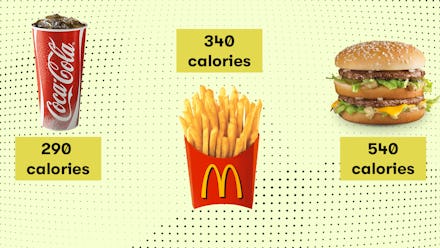Calorie counts are now required at every chain restaurant in America

All chain restaurants in the United States are required to publish calorie counts on their menus as of Monday. The push for nutritional transparency is one that’s been a long time in the making. The ruling was passed as a part of the Affordable Care Act and was originally meant to roll out in 2015, but faced strong opposition from smaller regional chains.
“Calories are really important because obesity is one of the most pressing health problems of our day, contributing to heart disease, cancer and especially diabetes,” said Margo Wootan, the vice president for nutrition at the Center for Science in the Public Interest. She’s been working on the campaign for this change since 2002.
Calories aren’t everything when it comes to maintaining a healthy weight, but according to Wootan, they can be an indicator for portion size and other nutritional elements of food. “Calories are not the only piece of information people need, but they can give people a general idea of the size and a basis for comparing,” she said.
“This is definitely an important and long-overdue step in providing greater transparency around the health impacts of the food that we eat,” Alexa Kaczmarski, national campaign organizer for nonprofit organization Corporate Accountability said. But, as she put it, “It’s really important that this be a floor, not a ceiling.” The U.S. is far behind other countries when it comes to food labeling and transparency. In Chile, for example, a recent initiative requires black warning labels to be posted on packaged foods high in calories, sugar, salt or saturated fat.
And there’s something a bit curious about this ACA rule finally getting the OK during the Trump administration, Kaczmarski said. “It’s interesting that Trump’s [Food and Drug Administration] is supporting this, and it begs the question, ‘Why now?’ — especially under an administration that is beholden to corporations,” she said.
It’s possible that the ruling was ushered in as a pre-emptive measure against even more detailed label requirements that are being negotiated in North American Free Trade Agreement talks, Kaczmarski said. As the New York Times reported in March, several countries have discussed using symbols on packaged goods, like those in Chile, to combat the obesity epidemic. While Mexico and Canada were open to Chile’s way, the U.S. opposed it. “The American provision seeks to prevent any warning symbol, shape or color that ‘inappropriately denotes that a hazard exists from consumption of the food or nonalcoholic beverages,’” the Times reported. Corporations against any further transparency may now have leverage; by implementing the new national calorie law, they’ll be better equipped to argue, “Well, we did our part.”
The impact of menu labeling, and whether it can change consumer behavior, is still being explored. Previous research has weakened the argument for posting calories, showing that consumer habits barely change when the information is present. But, Wootan said, “Part of that is because there have been a lot of smaller, poorly designed studies that aren’t big enough to pick up statistically significant information.” More recent work from Cochrane shows that posting calories on menus could reduce the number of calories people consume. Even more, forthcoming research that will be published in the Journal of Consumer Psychology shows that a simple tweak could change the decisions consumers make. Researchers found that if calories were posted before menu items, rather than after them, diners would be more likely to eat less.
“In one study at a casual chain restaurant on an American college campus, we found that diners who chose from a menu with calorie information displayed to the left of the food items ordered meals with 28.4% fewer calories compared to diners who chose from a menu without calorie information,” the study authors wrote in Stat. “By comparison, diners who chose from a menu with calorie information to the right of each menu item ordered meals with only 5.4% fewer calories.” Calories are most typically presented after the name of the menu items, but researchers say changing this could change how much we eat.
Assuming that calorie listings do encourage diners to size down, does ordering a small size of McDonald’s fries instead of a medium size really make much of a difference, save for shaving off a little more than 100 calories? Actually, yes.
“The whole obesity epidemic is explained by an extra 200 calories per person per day,” Wootan said, nothing that even a slight caloric reduction is a positive thing. Having the option to size down may also lead consumers to find that 230 calories worth of fries might be just as satisfying as 340 calories worth.
The new calorie requirement aims to make it easier for consumers to make better decisions, and it will also encourage the food industry to be more mindful about nutrition, Wootan said. “Another goal of menu labeling is to provide an incentive for restaurants to improve their menus,” she explained, noting that she’s seen restaurants reduce their massive portion sizes or try out less fattening ingredients to reduce the calories in their dishes.
At Starbucks, for example, the classic coffee cake contained 440 calories in 2012. It now contains 390. More significantly, the chicken and broccoli pasta at Ruby Tuesday contained 2,060 calories in 2007, and today has 1,439.
Still, calories are only one part of a food’s nutrition profile. As Kaczmarski said, McDonald’s may serve meals under 400 calories, but they still may have a whopping amount of salt or sugar. “The meals aren’t necessarily healthy because they meet a certain calorie count,” Kaczmarski said. At the end of the day, it’s still very much the responsibility of the consumer to decipher what constitutes a more healthful choice. We now have a little more information to help us do so.